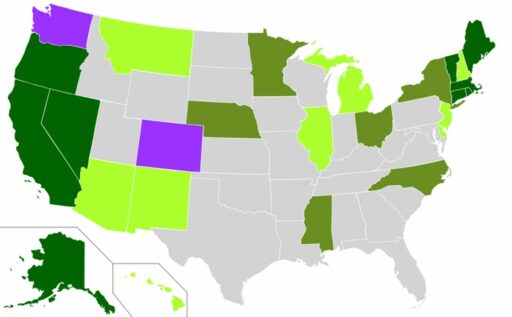The landscape of marijuana legalization in the United States has undergone significant changes, with a growing number of states embracing both medical and recreational use. The movement toward legalization has been marked by a combination of voter initiatives and legislative actions, reflecting a shift in public opinion and the recognition of the potential benefits of regulated cannabis markets. This article provides an updated count of states that have legalized marijuana, examining the nuances of laws and the progress of decriminalization efforts across the nation.
Key Takeaways
- As of 2023, recreational marijuana is legal in 24 states, with Ohio being the most recent addition following voter approval.
- Medical marijuana is legal in 37 states, with a majority having passed such laws through ballot initiatives.
- Decriminalization of marijuana has occurred in several states, reducing or eliminating jail time for possession of small amounts.
- Despite the increasing state-level legalization, cannabis remains illegal under federal law, creating a complex regulatory environment.
- The federal response to state marijuana legalization has been slow, with no comprehensive policy changes at the national level as of early 2024.
Overview of Marijuana Legalization in the United States

States with Legal Recreational Marijuana
As of January 2024, the landscape of marijuana legalization in the United States has seen significant changes. Now, in January 2024, there are 24 states that have embraced the legalization of recreational marijuana. This shift reflects a growing acceptance of cannabis use among adults, paralleling the legal treatment of alcohol.
The following states have legalized recreational marijuana, allowing adults aged 21 and over to purchase and possess cannabis subject to state regulations:
- Alaska
- Arizona
- California
- Colorado
- Connecticut
- Delaware
- Illinois
- Maine
- Maryland
- Massachusetts
- Michigan
- Minnesota
- Missouri
- Montana
- Nevada
- New Jersey
- New Mexico
- New York
- Ohio
- Oregon
- Rhode Island
- Vermont
- Virginia
- Washington
In addition to these states, recreational marijuana is also legal in Guam and the Northern Mariana Islands. However, it’s important to note that while cannabis is legal for recreational use in these jurisdictions, the specifics of purchase and possession limits can vary by state.
Each state has developed its own framework for the regulation and taxation of marijuana, creating a patchwork of laws that can be challenging for residents and visitors to navigate.
Medical Marijuana Legalization
The movement for medical marijuana legalization has seen significant progress across the United States. As of the latest count following the November 2022 midterm election, medical marijuana is legal in 37 states. This achievement is a testament to the persistent efforts of advocates and the growing recognition of marijuana’s therapeutic potential.
The path to legalization has varied from state to state. Eighteen states have passed medical marijuana laws through direct voter initiatives, reflecting a trend towards using ballot measures to enact policy changes. These states include pioneers like California and Oregon, as well as more recent additions such as Oklahoma and South Dakota. The remaining 19 states have seen medical marijuana laws enacted through legislative processes.
The widespread legalization of medical marijuana underscores a shift in public opinion and a greater acceptance of cannabis for its medicinal benefits.
The following table summarizes the modes of legalization for medical marijuana in the United States:
| Mode of Legalization | Number of States |
|---|---|
| Ballot Initiative | 18 |
| Legislative Action | 19 |
Recent Legalization Developments
The landscape of marijuana legalization is continually evolving, with states frequently updating their policies to reflect changing attitudes and knowledge. Recent legislative changes have emphasized social equity and criminal justice reforms, aiming to address the historical impact of marijuana prohibition. For instance, some states have introduced provisions for small businesses and social equity licenses, ensuring that the benefits of legalization extend to communities previously marginalized by drug laws.
Recent ballot initiatives and legislative actions have led to a variety of outcomes across different states:
- Maryland: Approved criminal justice reforms, including record sealing provisions, but lacks social equity and employment protections. Home grow has been decriminalized.
- Missouri: Approved expungement provisions and proposed a Cannabis Business Assistance Fund to support minority and women-owned businesses. However, employment protections are not in place, though home grow is permitted.
The federal response to these state-level changes remains sluggish, with nearly half of U.S. states having legalized recreational cannabis. This disconnect highlights the complexity of navigating marijuana laws within the United States.
The Path to Legalization: Ballot Initiatives and Legislation

Role of Direct Democracy in Marijuana Legalization
Direct democracy has played a pivotal role in the marijuana legalization movement in the United States. Ballot initiatives have allowed voters to directly influence marijuana policy, often in states where legislative action was slow or non-existent. This approach has been particularly effective in states with provisions for citizen-led ballot measures.
Since the landmark California vote in 1996, the trend of using ballot initiatives to legalize marijuana has grown. As of the latest data, 18 states have passed medical marijuana laws through this method. The success of these initiatives often reflects public opinion, which can be ahead of political leadership on the issue.
The use of direct democracy has not only changed laws but also sent a clear message to legislators about the public’s stance on marijuana legalization.
The table below summarizes the number of states that have legalized medical marijuana through ballot initiatives:
| Year | States Legalized via Ballot |
|---|---|
| 1996 | California |
| … | … |
| 2022 | Additional states |
Legislative Actions Leading to Legalization
The legislative journey toward the legalization of marijuana has been marked by a series of significant milestones. Legislatures across the United States have been actively shaping the landscape of cannabis policy, often through comprehensive bills that address possession, consumption, and the commercial aspects of marijuana. For instance, Senate Bill 3335, if enacted, would mark a substantial shift in the state’s approach to cannabis, allowing adults to possess, cultivate, and use marijuana within specified limits.
The legislative process is not just about passing laws but also about refining them to reflect public opinion and social equity concerns. Activists have played a crucial role in this, proposing amendments to legislation like SB 3335 to address perceived shortcomings, such as the THC limit for drivers and public consumption restrictions.
The table below represents a snapshot of recent legislative actions and their outcomes:
| Year | Legislation | Outcome |
|---|---|---|
| 2023 | SB 3335 | Pending |
As the legislative landscape continues to evolve, it is clear that the path to legalization is complex and multifaceted, with each state navigating its own unique set of challenges and opportunities.
Challenges and Setbacks in Legalization Efforts
Despite the momentum behind marijuana legalization, the journey is fraught with challenges and setbacks. One significant hurdle is the inconsistency of laws across jurisdictions. As highlighted by Investopedia, the cannabis industry faces the complexity of navigating varying laws not just between states, but also internationally. This patchwork of regulations creates a challenging environment for businesses and advocates alike.
In some states, progress has been stalled by legal and bureaucratic hurdles. For example, Oklahoma’s attempt to legalize adult-use marijuana was impeded by a new signature verification process, which led to a missed certification deadline and subsequent legal challenges. This illustrates how procedural issues can derail reform efforts, even when there is substantial support.
Advocates have also been active in proposing amendments to existing legislation to address perceived shortcomings. In one case, activists sought to remove certain driving limits and public consumption restrictions, aiming to create a more equitable and accessible market. These ongoing efforts underscore the dynamic nature of the legalization landscape, where laws and policies are continually being reviewed and contested.
The path to legalization is not linear, and each state’s journey reflects a complex interplay of advocacy, legislation, and public opinion.
State-by-State Breakdown of Marijuana Laws

States with Recreational and Medical Marijuana
As of the latest count, 24 states have embraced full legalization of marijuana, treating it akin to alcohol for adults aged 21 and over. This means that in these states, not only can adults legally purchase marijuana for recreational use, but they also have access to medical marijuana programs. The specifics, such as purchase limits and consumption locations, can vary from state to state.
The list of states that have legalized both recreational and medical marijuana includes:
- Alaska
- Arizona
- California
- Colorado
- Connecticut
- Delaware
- Illinois
- Maine
- Maryland
- Massachusetts
- Michigan
- Minnesota
- Missouri
- Montana
With the majority of Americans now living in states where marijuana is legal in some form, the landscape of cannabis legality is rapidly evolving. The inclusion of new states in 2023 highlights the ongoing trend towards widespread acceptance and regulation.
It’s important to note that while these states have legalized marijuana, there are still areas within the United States where sales are not permitted, despite legalization. This creates a complex patchwork of laws that consumers and businesses must navigate carefully.
States with Medical Marijuana Only
While the landscape of marijuana legalization is ever-changing, a significant number of states have established laws permitting the use of marijuana for medical purposes only. These states have recognized the therapeutic benefits of cannabis and have created frameworks to allow patients with qualifying conditions to access medical marijuana treatments. However, these states have not yet taken the step to legalize recreational marijuana use.
The following states have legalized medical marijuana but do not allow broader recreational use:
- Alabama
- Arkansas
- Delaware*
- Florida
- Hawaii*
- Kentucky
- Louisiana
- Minnesota*
- New Hampshire*
- New Mexico*
- North Dakota*
- Ohio*
- Oklahoma
- Pennsylvania
- Puerto Rico
- South Dakota
- Utah
- Virginia*
- West Virginia
*These states have also decriminalized marijuana, reducing or removing jail time for possession of limited amounts of weed.
It’s important to note that the status of marijuana laws can evolve rapidly, as seen in states that have recently transitioned from medical-only to full legalization through ballot initiatives or legislative actions.
States with Limited Access to Low-THC Products
In the landscape of marijuana laws across the United States, a handful of states stand out for their limited access to low-THC or CBD-only products. These states have not embraced broader medical or recreational marijuana legalization, nor have they decriminalized cannabis. However, they do allow the use of products with low levels of THC, primarily for medical purposes.
The following states permit access to low-THC products:
- Georgia
- Indiana
- Iowa
- Kansas
- Nebraska
- North Carolina
- South Carolina
- Tennessee
- Texas
- Wisconsin
- Wyoming
Idaho remains the sole state without any form of legal access to THC or CBD products.
While these regulations provide some level of legal access, they do not equate to a comprehensive medical marijuana program. The impact of these limited laws is significant, as they reflect a cautious approach to cannabis legalization, often focusing on specific medical conditions or patient groups.
Decriminalization vs. Legalization

Understanding the Difference
The terms ‘decriminalization’ and ‘legalization’ are often used interchangeably when discussing marijuana laws, but they represent very different legal realities. Decriminalization typically refers to the reduction of legal penalties for certain acts, in this case, the possession of small amounts of marijuana. Instead of facing criminal charges, individuals are subject to lesser penalties such as fines or civil infractions.
Legalization, on the other hand, involves the removal of all legal prohibitions against marijuana, allowing for its regulated production, sale, and use. This creates a legal framework within which marijuana can be consumed and distributed without fear of criminal repercussions.
While decriminalization can be seen as a step towards full legalization, it does not address the larger issues of the marijuana market and its regulation. Legalization aims to control and oversee the entire process, from cultivation to consumption, ensuring safety and legal compliance.
States That Have Decriminalized Marijuana
Decriminalization of marijuana represents a significant shift in how states approach cannabis policy. Decriminalization reduces or eliminates criminal penalties for possession of small amounts of marijuana, distinguishing it from full legalization. This approach has been adopted by a number of states, reflecting a growing trend towards more lenient laws concerning cannabis.
In states with decriminalization measures, possession of small amounts of marijuana typically results in a fine or civil infraction rather than jail time. Some states have also implemented measures such as suspended sentences for first offenses, aiming to reduce the long-term impact on individuals’ lives. It’s important to note that decriminalization does not equate to legal retail sales of cannabis; it merely alters the legal repercussions associated with possession.
While not all states have moved towards full legalization, the decriminalization of marijuana is a step that can pave the way for future policy changes and reflects a shift in public opinion and state legislation.
Below is a list of states that have decriminalized marijuana, indicating a move away from punitive measures:
- Alabama
- Arkansas
- Delaware*
- Florida
- Hawaii*
- Kentucky
- Louisiana
- Minnesota*
- New Hampshire*
- New Mexico
- North Dakota
- Ohio*
- Oklahoma
- Pennsylvania
- Puerto Rico
- South Dakota
- Utah
- Virginia*
- West Virginia
*States marked with an asterisk have also reduced or removed jail time for possession of limited amounts of weed.
Impact of Decriminalization on Legalization Movements
The journey towards marijuana legalization in various states has often been preceded by decriminalization efforts. Decriminalization acts as a critical stepping stone, paving the way for full legalization by shifting public perception and reducing the stigma associated with cannabis use. Decriminalization typically involves reducing penalties for possession and use, which can lead to broader reforms in criminal justice and social equity.
Decriminalization has shown to influence subsequent legalization movements by creating a more favorable environment for policy change. It often introduces measures such as expungement of past convictions, which not only address historical injustices but also garner public support for further legalization.
The following table highlights the impact of decriminalization on legalization efforts:
| Aspect | Impact of Decriminalization |
|---|---|
| Public Perception | Improved acceptance and reduced stigma |
| Criminal Justice | Lower arrest rates and expungement provisions |
| Policy Change | Increased momentum for legalization initiatives |
Decriminalization ordinances in localities, such as those in Ohio, have demonstrated the potential for grassroots movements to effect change at the state level. These local efforts often reflect the public’s growing demand for reform and can lead to statewide ballot initiatives or legislative actions aimed at legalization.
Navigating the Complex Landscape of Marijuana Sales

Regulations Governing Marijuana Sales
The landscape of marijuana sales is governed by a complex web of regulations that vary significantly from state to state. Each state with legalized marijuana has developed its own set of rules and guidelines to oversee the cultivation, distribution, and retail of cannabis products.
- In states where recreational marijuana is legal, regulations often include licensing requirements for growers, processors, and retailers, as well as strict zoning laws where cannabis businesses can operate.
- States also impose limits on the amount of marijuana that can be purchased and possessed by an individual.
- Additionally, quality control and product testing are mandated to ensure consumer safety.
The goal of these regulations is to create a controlled environment that curtails illegal activity while providing safe access to cannabis for adults.
Taxation is another critical aspect of marijuana sales regulation. States have implemented various tax structures to benefit from the legal cannabis market, with some earmarking funds for education, substance abuse programs, and law enforcement. The table below summarizes the tax rates in a selection of states with legal recreational marijuana:
| State | Tax Rate on Marijuana Sales |
|---|---|
| California | 15% + local taxes |
| Colorado | 15% excise tax + 15% sales tax |
| Washington | 37% excise tax |
| Oregon | 17% state tax + up to 3% local tax |
While the regulatory frameworks are designed to support a burgeoning industry, they also present challenges for businesses navigating compliance and for consumers seeking clarity on what is permissible.
Areas with Legal Weed but No Sales
In some regions, marijuana has been legalized for recreational use, yet commercial sales remain prohibited. This creates a unique situation where individuals may legally possess and consume cannabis, but cannot purchase it through regulated channels. Washington, D.C. is a prime example, where residents can grow and possess marijuana but are unable to buy it from commercial retailers.
The following list outlines areas with legal recreational marijuana but no sales:
- District of Columbia
- Guam
- Northern Mariana Islands
While these areas allow for personal use and cultivation, the lack of a legal marketplace limits access and fails to capitalize on potential tax revenues.
It’s important to note that these regions differ from states that have legalized medical marijuana without allowing recreational use. States like Alabama and Arkansas fall into this category, offering limited access to cannabis for qualifying patients only.
Federal Response to State Legalization
The federal response to state legalization of marijuana has been a complex and evolving issue. Despite the growing number of states that have legalized marijuana in some form, it remains illegal under federal law. This discrepancy creates a challenging landscape for states, businesses, and individuals navigating the legalities of marijuana use and sales.
The most substantial cannabis legislation from 2023 would legalize cannabis at the federal level and set forth a framework for consistent regulation across states.
Federal agencies have adopted a variety of stances, with some choosing not to enforce federal marijuana laws in states where it is legal, while others maintain strict prohibition. The tension between state and federal law has prompted calls for a unified federal approach to marijuana policy.
Here is a summary of key federal actions and their implications:
- Guidance and memos: Issued by federal agencies to clarify enforcement priorities.
- Banking access: Efforts to provide legal marijuana businesses with access to banking services.
- Research expansion: Increased support for research into marijuana’s medical benefits and risks.
- Legislative proposals: Introduction of bills aimed at reconciling state and federal laws.
Conclusion
As the landscape of marijuana legalization continues to evolve across the United States, we now see a significant shift towards acceptance and regulation. With 24 states, including Ohio as the latest addition in 2023, legalizing recreational marijuana, and 37 states permitting medical use, the trend is clear: the nation is moving towards a more lenient stance on cannabis. Despite the federal government’s slower response, the will of the people, often expressed through ballot initiatives, is reshaping the legal framework around marijuana. However, there remains a patchwork of laws, with 12 states still holding firm on prohibition. As we look to the future, it’s evident that the conversation around marijuana legalization is far from over, with potential for further changes on the horizon.
Frequently Asked Questions
How many states have legalized recreational marijuana as of 2023?
As of 2023, 24 states have legalized recreational marijuana, including the new additions made during the year.
Which states recently legalized recreational marijuana?
The most recent states to legalize recreational marijuana are Maryland and Missouri, following the November 2022 midterm election.
How many states allow medical marijuana?
Marijuana remains legal for medical use in 37 states.
What are the regulations for recreational marijuana use in Ohio?
In Ohio, adults over 21 can possess 2.5 grams of cannabis and grow up to six plants for personal use.
Are there any states where marijuana is completely illegal?
Yes, cannabis is still more or less wholly illegal in 12 states as of 2023.
Which states have decriminalized marijuana?
Several states have decriminalized marijuana, reducing or removing jail time for possession of limited amounts, including Colorado, Connecticut, Delaware, Illinois, Maine, Maryland, Massachusetts, Michigan, Minnesota, Missouri, Montana, Nevada, New Jersey, New Mexico, New York, Ohio, Oregon, Rhode Island, Vermont, Virginia, and Washington.





